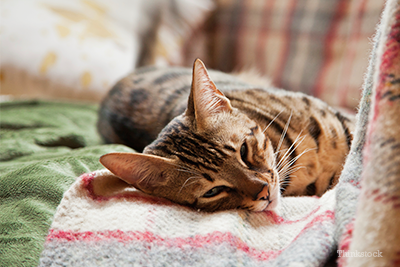Feline hypoparathyroidism occurs uncommonly. It results from the end of production of parathyroid hormone (PTH). Of the small number of cases documented, hypoparathyroidism seems to occur more commonly in young to middle-aged mixed breed cats with equal representation of males and females1.  What is parathyroid hormone (PTH)?
What is parathyroid hormone (PTH)?
PTH is manufactured within the cat’s parathyroid glands. These tiny glands are embedded within the two thyroid glands. All of these glands are located on the underside of the neck, just beneath the skin’s surface.
PTH is in charge of regulating blood calcium and phosphorus levels. It does so by modifying the amount of calcium and phosphorus that is:
- Absorbed by the gastrointestinal tract
- Eliminated via the kidneys
- Released from bones into the bloodstream
The results of hypoparathyroidism (too little PTH produced by the parathyroid glands) are decreased blood calcium and increased blood phosphorus levels.
Causes of hypoparathyroidism
It is unknown why the parathyroid glands spontaneously quit producing PTH. Immune-mediated destruction of the parathyroid glands (the immune system attacks the body’s own tissues) is suspected.
Damage or removal of the parathyroid glands during surgical removal of the thyroid glands is a more common cause of hypoparathyroidism. This surgery is sometime used to treat feline hyperthyroidism (overproduction of thyroid hormone).
Symptoms of hypoparathyroidism
The symptoms associated with hypoparathyroidism are the result of the abnormally low blood calcium level. The symptoms can be intermittent, particularly early on in the course of the disease. The most common symptoms include:
- Muscle tremors or twitching
- Uncoordinated gait
- Seizures
- Lethargy/weakness
- Loss of appetite
- Mental dullness
Diagnosis of hypoparathyroidism
The testing typically performed to arrive at a diagnosis of hypoparathyroidism includes:
- Complete blood cell count
- Blood chemistry profile (includes calcium and phosphorus measurements)
- Ionized calcium measurement
- Urinalysis
- PTH measurement
Treatment of hypoparathyroidism
Therapy for hypoparathyroidism consists of administration of vitamin D and calcium. Vitamin D supplementation is necessary to assist with the absorption of dietary calcium from the gastrointestinal tract.
Treatment with intravenous fluids and calcium is warranted for cats with severe symptoms. For those who are in stable condition, the calcium and vitamin D can be administered orally at home. Both are given daily (may be multiple times daily) and the dosages are adjusted based on the cat’s symptoms as well as follow-up blood calcium and phosphorus levels. Lifelong therapy is required, unless the condition is secondary to damage to the parathyroid after surgery for feline hyperthyroidism, in which case it can resolve after weeks to months.
Prognosis of hypoparathyroidism
With appropriate treatment and conscientious monitoring on the home front as well as by a veterinarian, the prognosis for feline hypoparathyroidism is excellent.
Questions to ask your veterinarian
- Do we know with certainty if my cat has hypoparathyroidism?
- What are other possible causes of my cat’s symptoms?
- Is my cat stable enough to be treated at home or should treatment be administered in the hospital?
- How frequently should my cat’s blood calcium and phosphorus levels be measured?
Resources:
